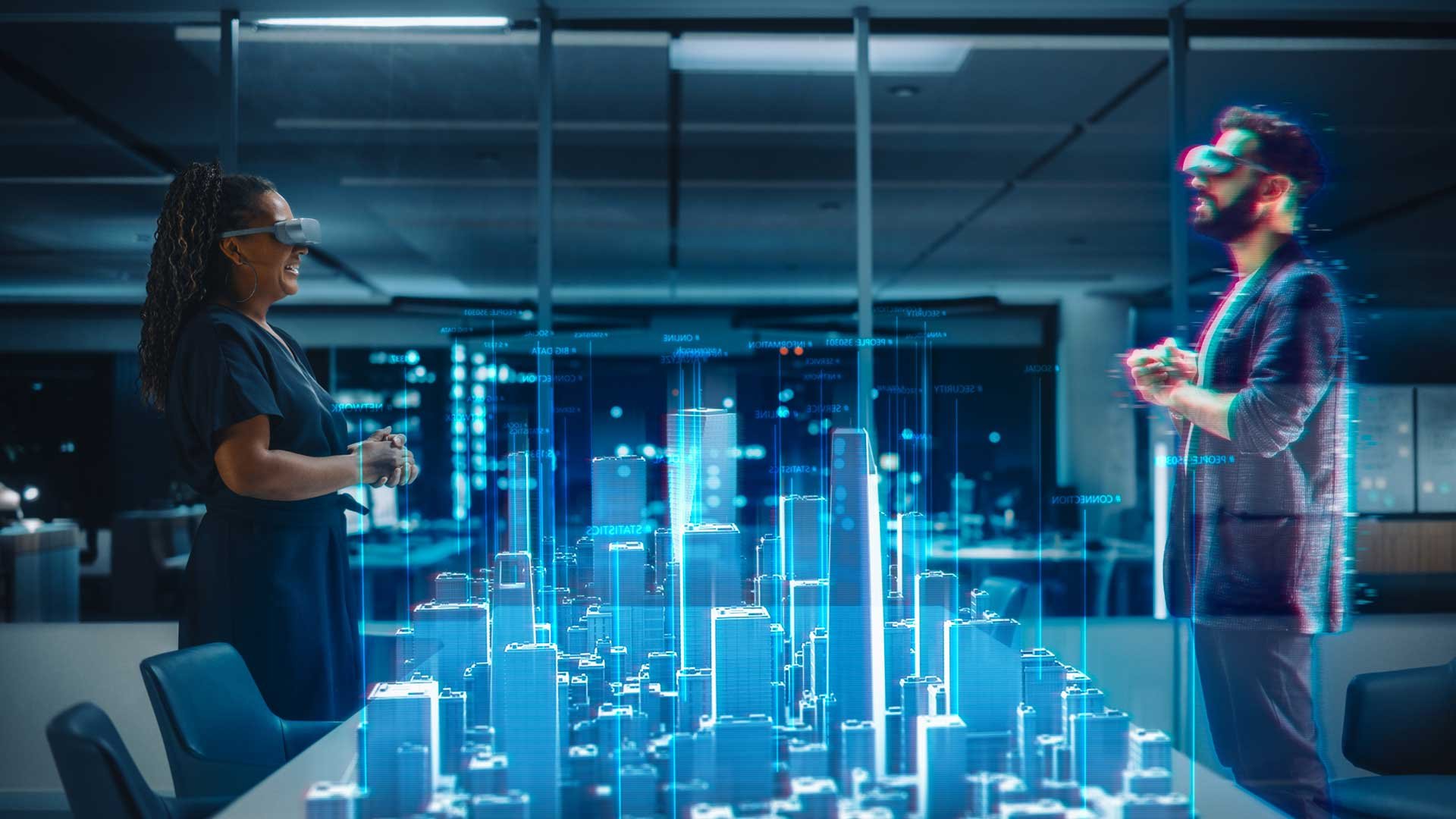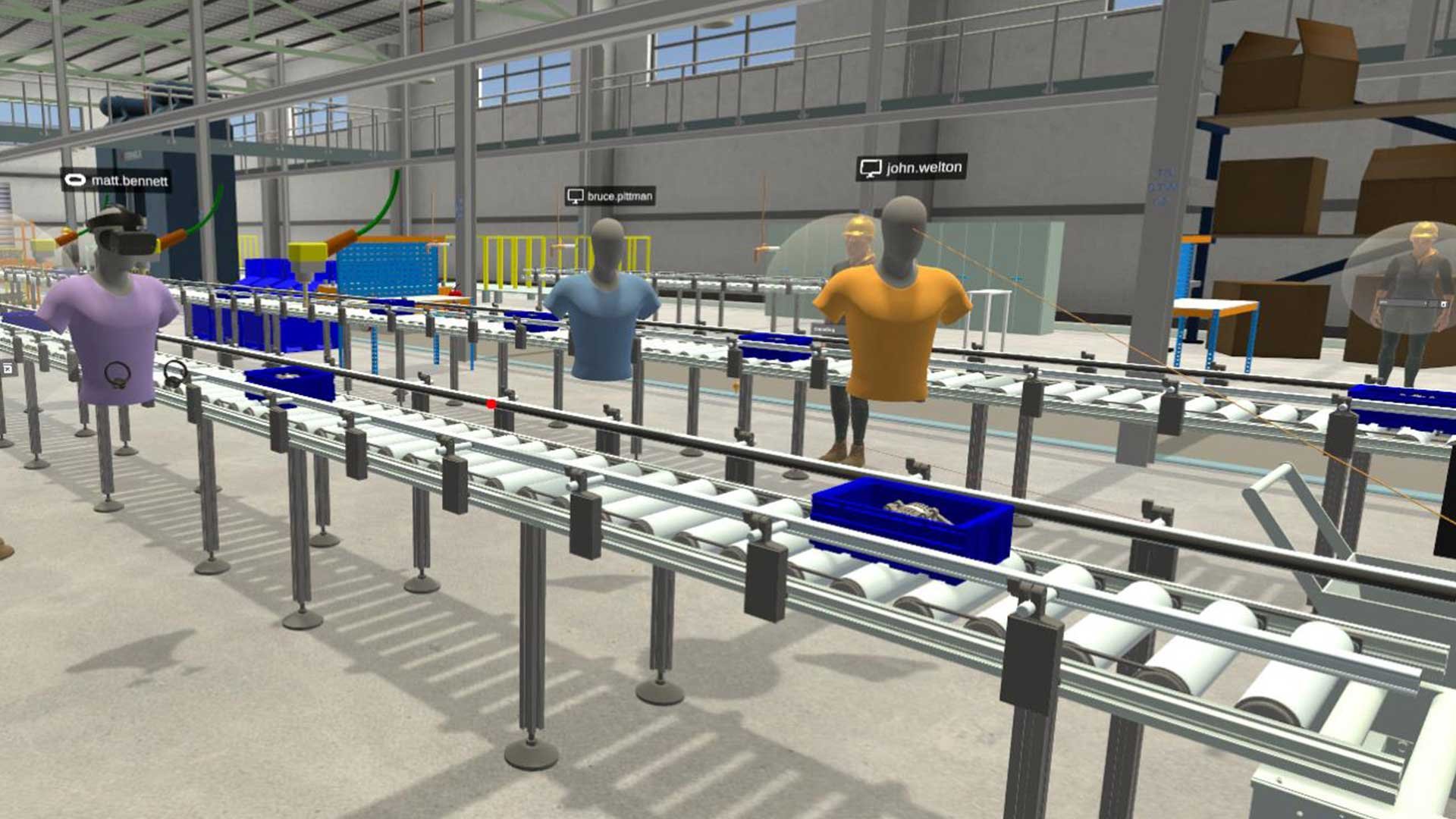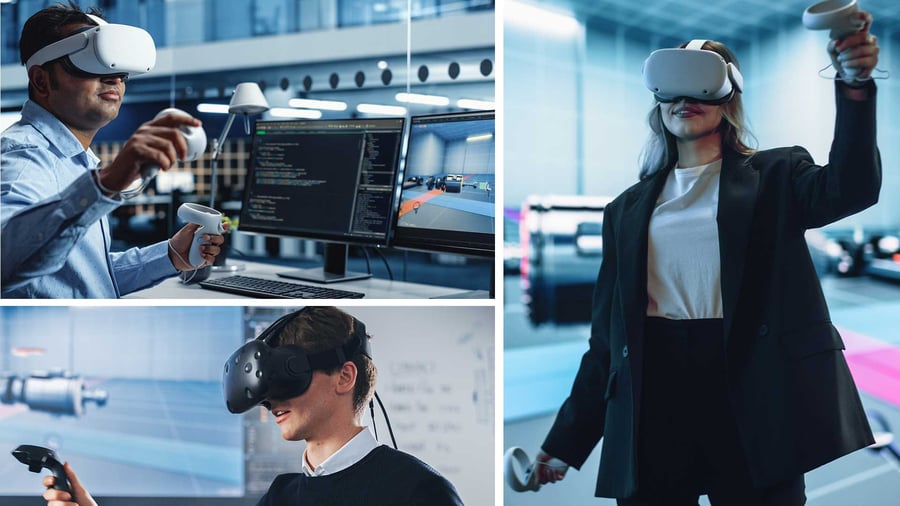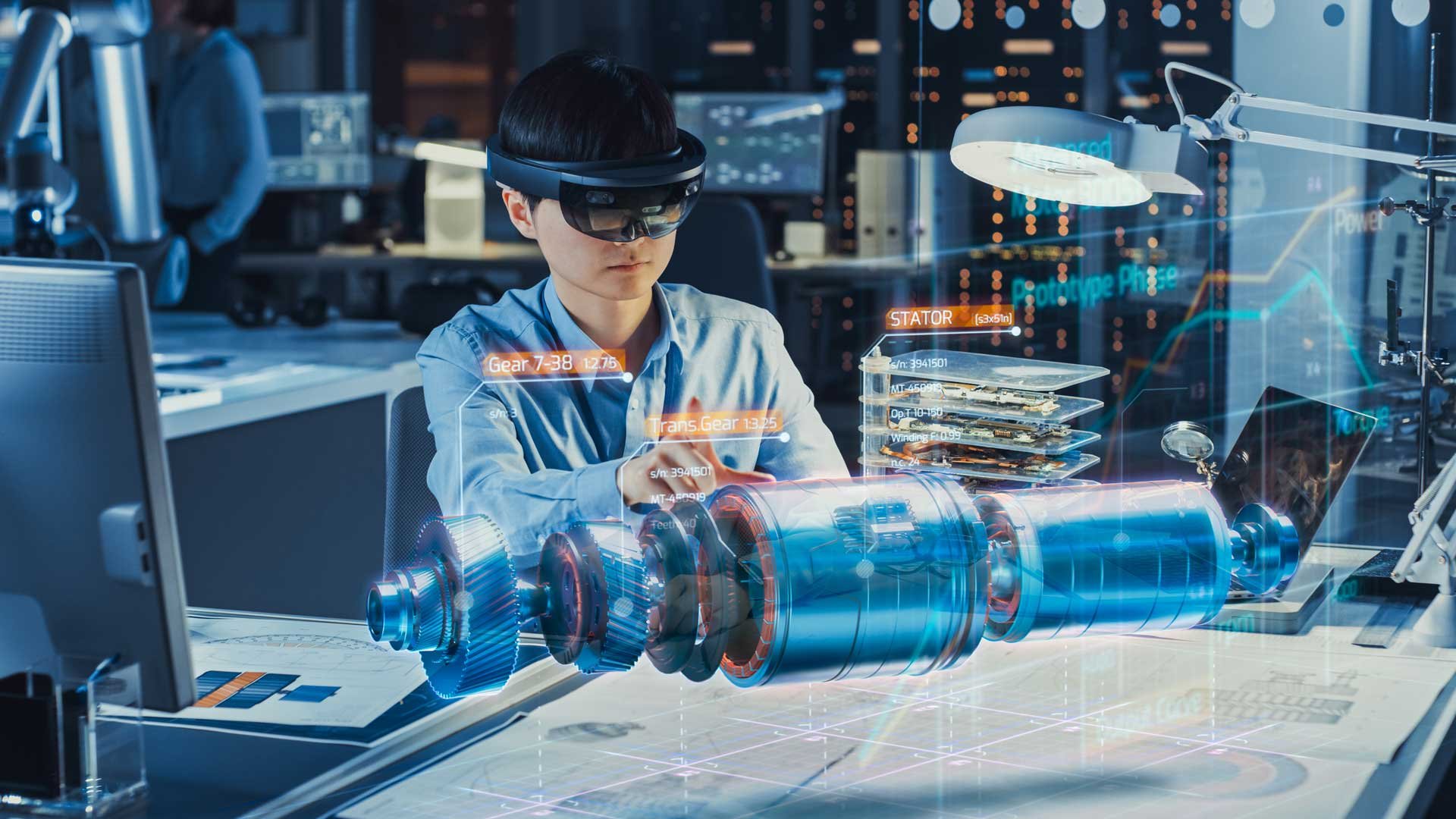An Introduction to the Metaverse
Although the concept of the metaverse seems to be a very recent trend, the term was first used in 1992 by Neil Stevenson in his novel, Snow Crash. It described a virtual world accessed by goggles where you could move about as an avatar; in the book it was used as an escape from the horrors of a dystopian world. Neil Stevenson imagined that this metaverse is what the internet would become, and although it’s too early to say whether he had the gift of prophecy, many industry leaders seem to think he may have been right (though hopefully without the dystopian world part).
The metaverse could change everything from entertainment, shopping, education, and the workplace. In the future many aspects of our lives may take place within the metaverse — in an immersive fully digital world accessed using headsets. One area that has already started embracing the metaverse is engineering and manufacturing, this “industrial metaverse” continues to grow as more companies explore the technology. However, the industrial metaverse is mostly self-contained, which prompts the question of whether there can be a single metaverse if different companies build their own versions.
The Rise in Popularity
Even though the term goes back to 1992, the concept of the metaverse has seen a sharp rise in popularity over the past few years. In April 2021, Epic Games, the developers of Fortnite and the Unreal Engine, announced they had secured $2 billion of funding to support them in building the metaverse. However, not too long after that, in October 2021, Facebook rebranded to Meta indicating their shift in focus to the metaverse, which sparked widespread interest in the technologies.
Epic Games and Meta likely have very different intentions for what they want the metaverse to be. It's probable that Epic Games will be focusing more on entertainment within the metaverse, at least to begin with. At GDC 2023, they announced that they would be paying for creator-generated content within Fortnight, to help their metaverse to grow. This comes after the release of Verse, Epic Games’ new programming language designed specifically for the metaverse. The hope for Verse is that this simple to learn and scalable language could facilitate the creation of the metaverse in the future, potentially even branching out into realms beyond entertainment.
Whereas Meta’s focus will be broader from the beginning, with a focus on connecting people in all aspects of life. Since their rebranding, Meta has continued to develop their metaverse projects. Despite showing interest in the recent AI trend, Mark Zuckerberg confirmed that Meta is still focusing on the metaverse saying, "We've been focusing on both AI and the metaverse for years now, and we will continue to focus on both." (Q1 2023 Earnings) He went on to suggest that AI could actually play an important part in the metaverse, such as by allowing worlds to be procedurally generated.
Another industry leader that has taken steps into the metaverse space is Microsoft. Microsoft Mesh is bringing the workplace into the metaverse through Mesh for Teams, which features customizable avatars, accessible through either desktop or VR, with the goal of connecting people in a way that is immersive and natural. Along with this, Microsoft is continuing to develop Mesh's capabilities. Recently released for public preview, the next addition to Microsoft's metaverse project will be immersive spaces for Teams designed to make remote meetings more natural.
Given this ongoing development of Mesh, it's evident that Microsoft believes the metaverse will be a huge part of how people collaborate in the workplace in the future. In his 2021 year in review, following the initial announcement of Mesh, Bill Gates discussed his expectations of the future of workplace meetings saying, “Within the next two or three years, I predict most virtual meetings will move from 2D camera image grids…to the metaverse, a 3D space with digital avatars.”
With many influential companies beginning the development of their own versions of the metaverse, it's difficult to understand what the metaverse actually is. Given the number of voices in this new space, there's no absolute definition as to what the metaverse will be; however, there are a few common features.
What is the Metaverse?
“In the metaverse, you’ll be able to do almost anything you can imagine — get together with friends and family, work, learn, play, shop, create — as well as completely new experiences that don’t really fit how we think about computers or phones today.” — Meta, Founder’s Letter, 2021
This is what comes to mind for many people when they think about the metaverse — an interconnected series of 3D digital worlds seen through a VR headset where you can interact with other people in real-time and can do almost anything you could do in the real world. However, since many separate companies are creating their own version of the metaverse, whether this interconnected series of worlds will be possible remains to be seen. It is instead feasible that ‘the metaverse’ will, in fact, be multiple metaverses.
However, the concept of the metaverse as a digital world accessed through Extended Reality (XR) devices (primarily Virtual Reality — VR) remains consistent throughout ideas of the metaverse. VR allows the user to be fully immersed in the virtual world, able to look around and see objects and people as if they were actually in front of them. VR is what makes the metaverse so appealing, it allows for better communication and collaboration and allows people to feel immersed in the space.

In the future, much of our lives may be in the metaverse, including our jobs. Commuting in the metaverse will be as simple as putting on a VR headset in your home and appearing at work. The lifelike environment VR provides is a great benefit for remote working, combining the benefits of working from home and seeing colleagues in person.
There has always been a disconnect between the digital and the real world because although all the necessary information is shown on the screen it can be difficult to put it into context. This is often referred to as the “Cognitive Gap.” However, VR is helping to close this gap and contextualize information by allowing users to visualize the data in an immersive space.
Despite the many benefits of VR, it is also one of the biggest obstacles to the realization of the metaverse. For one, not everyone owns a VR headset. However, VR has been getting more affordable as the technology develops and it’s possible that in the future it will be more widespread in the same way mobile phones are.
Another difficulty is that getting existing information and data into XR, and subsequently the metaverse, can be difficult if the data is not designed or optimized for it. As a result, if your company already works with data, transferring over to the metaverse can be challenging. This is an issue for engineering and manufacturing companies in particular, since being able to work with CAD data is vital.
What Can Theorem Bring to the Metaverse?
TheoremXR aims to eliminate this difficulty of getting CAD data into VR and other types of Extended Reality (XR) such as Augmented Reality (AR) and Mixed Reality (MR). The Visualization Pipeline makes it simple to use CAD data within XR, opening up opportunities for engineering and manufacturing companies to utilize VR and get a head start on transferring over to the metaverse. Plus, TheoremXR is data and device-agnostic, supporting multiple CAD formats and XR devices.

The Visualization Pipeline provides an automatic process for preparing and optimizing CAD data for use in XR. It can be run in batch mode and integrated with PLM processes, alternatively, simply drag and drop or save as from the CAD system. This data can then be used in internally developed applications or in Theorem Solutions’ XR Experiences.
We also have a range of engineering and manufacturing-focused XR experiences:
Design Review, which allows users to conduct design reviews remotely and collaboratively review 3D CAD models at scale from anywhere in the world using Mixed Reality or Virtual Reality headsets.
In addition to that, we have Training experiences that allow users to create training materials and work instructions for a worker to be taken through step by step in Mixed Reality or Virtual Reality. This means that much of training can be done completely digitally, without the risk of reducing productivity, damaging equipment, or risking injury.
Our Factory Layout and Planning Experience provides the ability to fully plan out a factory layout in a digital setting before committing to a design. Libraries of existing CAD data can be uploaded to create the layout in XR. This can be done collaboratively from anywhere in the world, allowing everyone to check for access issues and other faults.
Another experience we offer is Visual Digital Twin, where users can visualise a 3D digital model of a physical item in AR and MR. You can compare the two by overlaying the physical object with the digital model, making discrepancies and faults easier to spot.
Finally, Visualization lets users visualise 3D CAD data at full scale using VR and MR headsets. There is also a collaboration mode that allows remote working between colleagues on the same CAD model.
Visualising CAD data in XR allows faults and issues to be spotted and resolved early in the development process. This means that changes to a design can be made prior to a physical prototype being developed, saving time and money during the prototyping process.
Companies that already utilize Extended Reality will have a much easier time transitioning into the metaverse when it becomes more widespread. Workers will already know how to navigate XR and will be aware of the features available. Plus, the areas that are best suited to XR (utilizing visualisation and collaboration) will already be established.
How Could Engineering and Manufacturing Use the Metaverse?
At its core, the metaverse will expand on the benefits of Extended Reality for Engineering and Manufacturing companies by creating a more connected system that allows users to quickly navigate a wide variety of different metaverse environments and situations.

Collaborating remotely can save time and money on travel costs when the teams are globally distributed, as they often are in the engineering and manufacturing sector. With the ability to visualise CAD models in XR, a significant amount of development could be done completely remotely. The metaverse would allow a seamless transition from an immersive meeting room to a collaborative design review, without needing to leave your home.
Some engineering and manufacturing companies are already beginning to embrace the metaverse. In January 2022, Hyundai Motor Company and Unity announced their partnership, as Hyundai turned its attention to the metaverse. In their official release, Hyundai described the project as a ‘Meta-Factory’ and explained their plan for the partnership: “The partnership will realize Hyundai’s vision of becoming the first mobility innovator to build a Meta-Factory concept, a digital twin of an actual factory, supported by a metaverse platform. The introduction of a Meta-Factory will allow Hyundai to test-run a factory virtually in order to calculate the optimized plant operation, and enable plant managers to solve problems without having to physically visit the plant.”
Large projects like this one are likely to be a driving force for progressing the metaverse, particularly in engineering and manufacturing industries, since they allow other companies to see the potential of the metaverse without having to take any of the risks themselves. Although there will certainly be many obstacles to making the metaverse as commonplace as the internet, for example, large companies like Hyundai clearly think that the benefits are worth it.
“Real-time digital twins will permanently change how we live, work, shop and make a positive impact on our planet, representing a significant component of what is often referred to as the metaverse… Hyundai’s vision for the future, including the digital twin of factory operations, represents a significant technological step forward in manufacturing with unlimited potential in its efficiency.” — John Riccitiello, Chief Executive Officer (CEO), Unity.
The ability to prototype and review everything digitally first is a huge benefit to the engineering and manufacturing industry. And it isn’t just efficiency that is improved by this metaverse technology. Reviewing models in XR during development improves quality control as well, since more mistakes are caught and fixed before more ‘permanent’ decisions are made. This, along with the improved remote collaboration that the metaverse and XR can bring, more than make up for the initial challenges that come with adapting to a new technology.
In March 2023, Nokia and EY partnered for the “The Metaverse at Work” study, which looked into how industry leaders feel about the industrial metaverse. Their research found that 80% of experienced respondents believe that the industrial metaverse will have a significant or transformative impact on their business. Suggesting that there is a lot of interest in the metaverse in industrial settings. However, even more significantly, the study found that companies who had already implemented use cases reported more benefits than those in the planning phase predicted, suggesting that the benefits of implementing metaverse technologies exceed expectations.
Final Thoughts
Despite the initial work involved in setting a business up for XR and the metaverse, the benefits can be worth it. Reviewing the data in XR before having to make a physical model streamlines the manufacturing process, and the immersive collaboration allows for remote working while still having the benefits of traditional office working. Plus, Theorem Solutions’ Visualisation Pipeline simplifies preparing and optimizing CAD data for use in XR, meaning that much of the difficulty of working with CAD within XR is removed.

Although the metaverse seems a long way from becoming a widespread phenomenon it may be closer than it seems. The metaverse brings all the benefits of working in XR into an interconnected digital space, expanding on what XR already brings to the table. Although it’s difficult to tell what form the metaverse will take at this stage (whether it will be the singular digital world that people imagine or a few more specialised ‘metaverses’) as more and more companies invest in the technology it becomes more likely that the metaverse, however it ends up looking, will significantly influence everyone’s lives.
To learn more about the industrial metaverse or XR adoption for your organization, visit our TheoremXR page or get in touch with our team of specialists today. We’re here at every step of your XR journey. You can also follow us on LinkedIn for the latest XR news and updates.


